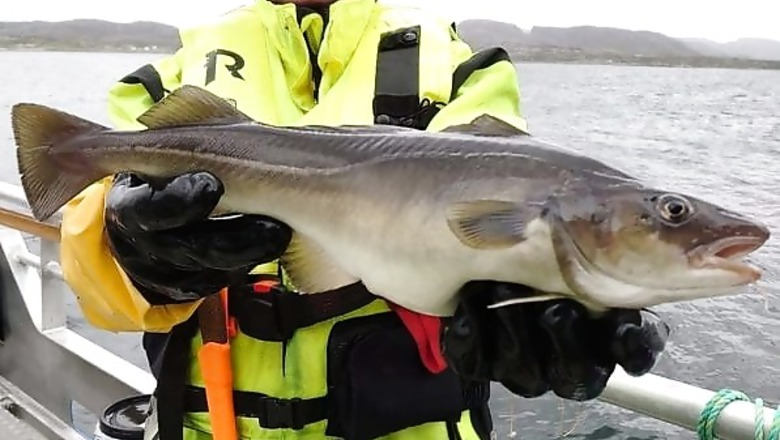
views
OSLO: Norway is relaunching cod farms in Europe’s ice-cold northern waters after mass escapes and failure to thrive condemned its earlier attempt to become the first country to try large-scale breeding of a species declining in the wild.
The handful of companies raising Atlantic cod in pens in Norwegian fjords say they have learned lessons from a wave of bankruptcies of cod farms earlier in the millennium as well as the success of Norway’s multi-billion-dollar salmon business.
They are hoping to emulate that success with cod at a time when wild Atlantic cod are seeing mixed fortunes.
While stocks off Iceland and in the Barents Sea are sustainable, those off Canada, the United States, Ireland and Britain are low, as are those in the Baltic Sea and the non-British part of the North Sea.
Norcod, the biggest of the new farms, is raising 1.8 million fish along the craggy Norwegian seacoast and plans to begin sales in the second quarter of 2021.
“We are targeting northern and western Europe first,” said Christian Riber, Norcod’s commercial director, adding the firm had also seen interest in their product from U.S. customers.
The company aims to produce an initial 6,500 tonnes in 2021, rising to 25,000 tonnes in 2025. That would exceed the high of 21,000 tonnes recorded in official statistics across the country in 2010 before the industry collapsed.
“They used wild fish for breeding and the cod was escaping by biting into the nets,” said Oeyvind Hansen, who heads the national cod breeding programme at Nofima, the only research institute that works with the selective breeding of cod.
Around half of all the fish raised in a pen died, including from cannibalism, he said. Growth rates were also slow and the 2008-2009 financial crisis starved companies of credit. By 2015, Norway produced no farmed cod at all.
Norway’s production of farmed salmon and cod Norway’s production https://graphics.reuters.com/NORWAY-COD/jbyvrqlkype/chart.png
WHAT CHANGED?
Nofima continued the research into cod breeding it had conducted since 2002-2003 thanks to public funding from a ministry of fisheries keen to develop new industries around fish. It has now bred five generations of farmed cod.
“Through selective breeding, the fish has adapted to farm life. It has become more domesticated,” said Hansen. “We have learned a lot about the biology and we have selected the fish best suited for fish farming.”
Mortality rates in the pens are down to roughly 15%, there is less cannibalism, faster growth and the fish no longer try to escape, he said. Norcod says its mortality rates were much lower.
“We are benefiting from the huge improvements in equipment for the salmon farming industry in the last decade,” said Norcod’s Riber.
Salmon farming has grown in two decades into a $8-billion dollar industry that exports 1.1 million tonnes of fish and is now Norway’s third-largest export after crude oil and natural gas, with logistics to match.
Norway’s top exports in 2019 https://graphics.reuters.com/NORWAY-COD/gjnvwawelvw/chart.png
WILD COD VS FARMED COD?
Not everyone is pleased about the revival of cod farming.
“We have sustainable cod stocks in the wild in many areas in Norway that are thriving,” said Arnold Haapnes, who heads the biodiversity programme at green group Friends of the Earth Norway. “So why should we use (public) money to compete with the wild cod?”
Farmed salmon regularly escape during storms and mate with the wild salmon, he said, causing introgression, the mixing of genes between wild fish and farm fish. This eventually lowers the amount of genes available in the wild population and makes it more vulnerable to disease and environmental changes, which are on the increase. https://reut.rs/3hNcSGn
Norcod said it was able to prevent escapes, including in bad weather, by using suitable equipment and with good routines, with frequent inspections of the nets to ensure there are no holes.
Authorities say cod farming can be developed sustainably with appropriate regulation and helps to provide healthy protein to a growing world population, especially since climate change is affecting wild fish stocks.
Fishing rights are a major issue within the European Union, and non-EU member Norway negotiates quotas and access with the bloc each year. It is also negotiating a bilateral trade deal with Britain — its biggest trading partner, as London negotiates its exit from the European Union.
In 2018, Norway exported close to 200,000 tonnes of cod globally, valued at 9.5 billion crowns ($1.1 billion), according to the Norwegian Seafood Council, a trade body, which said the largest markets were Portugal, Britain and France.
“We need to produce more healthy seafood,” said Fisheries Minister Odd Emil Ingebrigtsen, “And farmed cod can provide a regular source.”
(Editing by Philippa Fletcher)
Disclaimer: This post has been auto-published from an agency feed without any modifications to the text and has not been reviewed by an editor



















Comments
0 comment